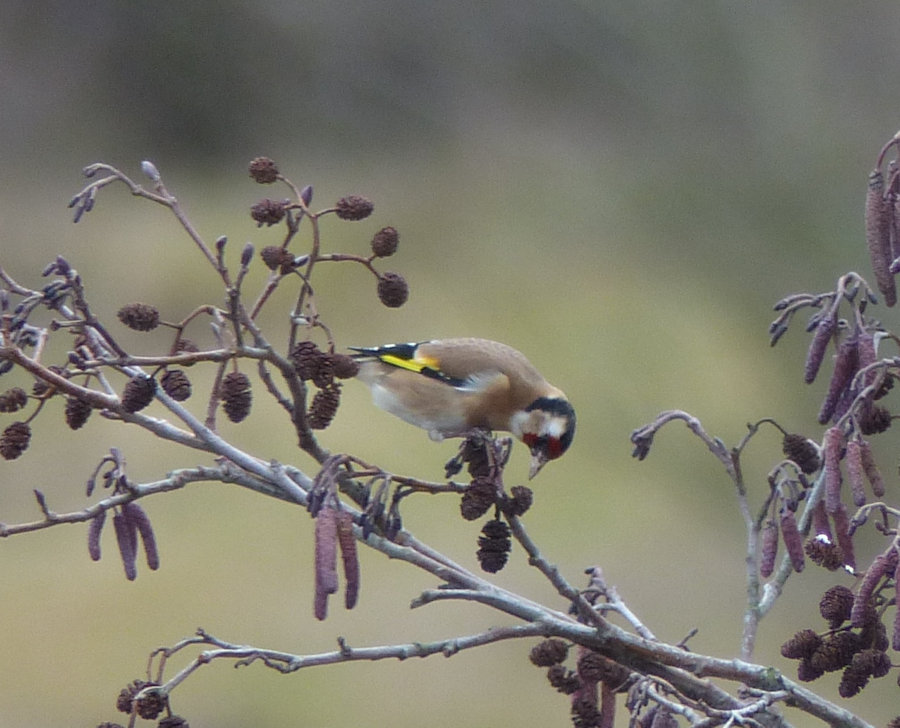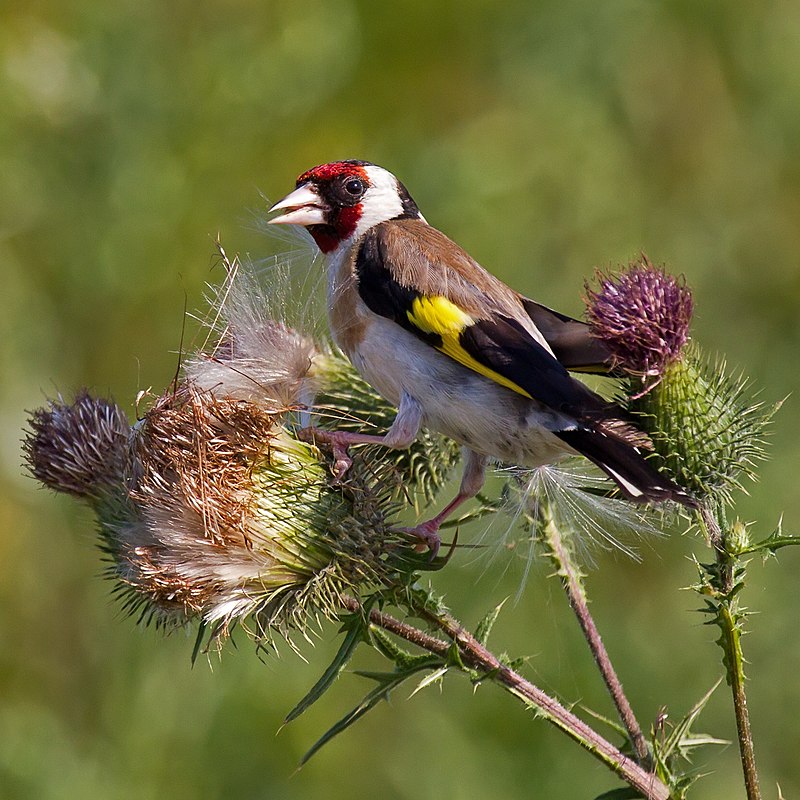Garden Wildlife
Garden Wildlife


Goldfinch Carduelis carduelis
This is the one bird that gives the lie to the idea that birds in Britain are mostly ‘little brown jobs’! It‘s certainly little but it’s colourful and charming – hence the collective noun for a flock of Goldfinches, a ‘charm’.
What do they eat?
Goldfinches are among the most obvious seed-eaters common in gardens. They will take seeds from feeders and the ground (especially niger (or nyjer) seeds, which are similar to their favoured natural food). In nature they are often seen eating thistle seeds in autumn, and almost any fine seed is taken (e.g dandelion, knapweed, reedmace). They often join other small finches in winter flocks and feed on tree seeds like alder and birch.
What do they do?
Apart from the distinctive flight call you can tell distant goldfinches by their bounding flight, lifting themselves up and dropping repeatedly as they course across the sky. That can be confirmed by the flash of their yellow wing patches. goldfinches spend much of the year in large flocks, often dozens of birds, sometimes mixed with other finches such as siskin or redpoll. Some goldfinches in the UK tend to stay here all year round, others apparently move to the south west of Europe in winter.
How are they doing?
Goldfinches have been increasing in numbers over the thirty years, by 300% since 1985. There are thought to be 1.7 million pairs in Britain in the summer. The increase in garden feeding and maybe the decline of greenfinches may have something to do with this.
Finding out more:
BTO profile on goldfinch
RSPB profile on goldfinch
Page written by Roy Smith, compiled by Steve Head
Feeding on spear thistle seeds Feeding on alder seeds
What do they look like?
A bit smaller (12cm) than a robin, with a short but pointed seed-eater bill. The colours are extraordinary. The sexes are similar and adults have a red face and forehead, with a black crown running down either side of the pale brownish nape. The cheeks are white, joining with a whitish throat and upper breast. The back is buffy brown in colour, with black and white tips to the main feathers on the wings, making for a black base to the back with narrow white stripes across it. The breast and flanks are pale buff. The wings have black angles at the front, with a bright yellow patch in the middle, and a black tips when folded. Young birds lack the bright colours on the face but still have the bright yellow wing patch. See our finches page for comparison with other species.
What do they sound like?
Goldfinches have a wispy, trilling, warbling song that was prized when they were kept as cage birds in earlier times. They sing it from a perch, often high in tree. The male doing the singing can be seen turning its head from side to side, giving a thrown-voice affect.
In flight they have a shorter distinctive call so you can sometimes identify a flock going over by the call alone.
Male song Flight call


Simon Elliott, XC647553. Accessible at www.xeno-canto.org/647553.
Micha Luhn, XC637359. Accessible at www.xeno-canto.org/637359.
Goldfinch Carduelis carduelis
This is the one bird that gives the lie to the idea that birds in Britain are mostly ‘little brown jobs’! It‘s certainly little but it’s colourful and charming – hence the collective noun for a flock of Goldfinches, a ‘charm’.


Feeding on spear thistle seeds Feeding on alder seeds
What do they look like?
A bit smaller (12cm) than a robin, with a short but pointed seed-eater bill. The colours are extraordinary. The sexes are similar and adults have a red face and forehead, with a black crown running down either side of the pale brownish nape. The cheeks are white, joining with a whitish throat and upper breast. The back is buffy brown in colour, with black and white tips to the main feathers on the wings, making for a black base to the back with narrow white stripes across it. The breast and flanks are pale buff. The wings have black angles at the front, with a bright yellow patch in the middle, and a black tips when folded. Young birds lack the bright colours on the face but still have the bright yellow wing patch.
What do they sound like?
Goldfinches have a wispy, trilling, warbling song that was prized when they were kept as cage birds in earlier times. They sing it from a perch, often high in tree. The male doing the singing can be seen turning its head from side to side, giving a thrown-voice affect.
In flight they have a shorter distinctive call so you can sometimes identify a flock going over by the call alone.
Male song Flight call
What do they eat?
Goldfinches are among the most obvious seed-eaters common in gardens. They will take seeds from feeders and the ground (especially niger (or nyjer) seeds, which are similar to their favoured natural food). In nature they are often seen eating thistle seeds in autumn, and almost any fine seed is taken (e.g dandelion, knapweed, reedmace). They often join other small finches in winter flocks and feed on tree seeds like alder and birch.
What do they do?
Apart from the distinctive flight call you can tell distant goldfinches by their bounding flight, lifting themselves up and dropping repeatedly as they course across the sky. That can be confirmed by the flash of their yellow wing patches. goldfinches spend much of the year in large flocks, often dozens of birds, sometimes mixed with other finches such as siskin or redpoll. Some goldfinches in the UK tend to stay here all year round, others apparently move to the south west of Europe in winter.
How are they doing?
Goldfinches have been increasing in numbers over the thirty years, by 300% since 1985. There are thought to be 1.7million pairs in Britain in the summer. The increase in garden feeding and maybe the decline of greenfinches may have something to do with this.
Finding out more:
Page written by Roy Smith, compiled by Steve Head
























